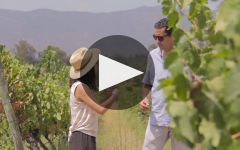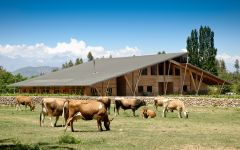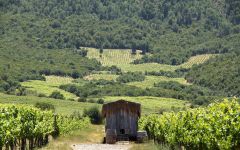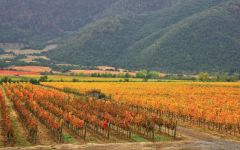Emiliana Coyam (Certified Biodynamic) 2014
-
James
Suckling -
Wine
Spectator -
Wine
Enthusiast



Product Details
Your Rating
Somm Note
Winemaker Notes
Pair with roasted red meats, strong cheeses and pasta with spicy sauces. Also marries well with dried fruits.
Professional Ratings
-
James Suckling
This is a leaner and fresh Coyam with stone, dark berry and hints of currant leaf. Medium to full body, pretty fruit and an intense finish. A blend of syrah, carmenere, cabernet sauvignon, mourvedre, malbec and petit verdot. From biodynamically grown grapes.
-
Wine Spectator
Dense and rich-tasting, with plenty of ripe dark plum, cherry and dried blackberry flavors that are loaded with Asian spice notes. Shows green herbal accents on the finish, with dark chocolate details. Syrah, Carmenère, Cabernet Sauvignon, Mourvèdre, Malbec and Petit Verdot. Drink now through 2021.
-
Wine Enthusiast
Compact plum and currant aromas are floral at first then more spicy and foxy as this blend led by Syrah and Carmenère airs out. A tough palate flush with tannins deals spicy, herbal plum flavors with ample chocolate and spice from oak. On the finish, this dries out and tastes peppery. Drink through 2022.
Other Vintages
2016-
James
Suckling -
Wine
Spectator
-
James
Suckling -
Robert
Parker
-
James
Suckling -
Robert
Parker
-
Wine
Enthusiast -
Wine
Spectator -
Robert
Parker -
Wine &
Spirits
-
Wine
Spectator -
Robert
Parker -
Wine
Enthusiast
-
Wine
Spectator
-
Wine
Enthusiast -
Wine
Spectator
-
Wine
Spectator
-
Wine
Spectator -
Robert
Parker








At Emiliana, the organic vineyards literally teem with life. Vineyards buzz with various bugs, bees, birds and native wildlife that together provide a natural and effective defense against common vine-destroying insects. Flowers and native plants thrive throughout the organic vineyards, providing another simple and cost-effective method of pest control and helping to counteract the detrimental effects of soil degradation. The use of chemicals is shunned, in favor of natural compounds, such as copper and nitrogen. Compost is sourced from spent grape skins and stems. Emiliana’s Natura range, which celebrated its U.S. debut in 2006, marks the cutting edge of an altogether new category of wines made from organically grown grapes – a collection of superbly made, affordably priced organic wines crafted expressly for everyday enjoyment and, accessible to all. The Natura collection features seven varietals, three whites and four reds, all produced from hand-picked, organic grapes, harvested from certified organic vineyards in the prime growing regions of Chile’s Central Valley.

With hundreds of red grape varieties to choose from, winemakers have the freedom to create a virtually endless assortment of blended red wines. In many European regions, strict laws are in place determining the set of varieties that may be used, but in the New World, experimentation is permitted and encouraged resulting in a wide variety of red wine styles. Blending can be utilized to enhance balance or create complexity, lending different layers of flavors and aromas. For example, a red wine blend variety that creates a fruity and full-bodied wine would do well combined with one that is naturally high in acidity and tannins. Sometimes small amounts of a particular variety are added to boost color or aromatics. Blending can take place before or after fermentation, with the latter, more popular option giving more control to the winemaker over the final qualities of the wine.
How to Serve Red Wine
A common piece of advice is to serve red wine at “room temperature,” but this suggestion is imprecise. After all, room temperature in January is likely to be quite different than in August, even considering the possible effect of central heating and air conditioning systems. The proper temperature to aim for is 55° F to 60° F for lighter-bodied reds and 60° F to 65° F for fuller-bodied wines.
How Long Does Red Wine Last?
Once opened and re-corked, a bottle stored in a cool, dark environment (like your fridge) will stay fresh and nicely drinkable for a day or two. There are products available that can extend that period by a couple of days. As for unopened bottles, optimal storage means keeping them on their sides in a moderately humid environment at about 57° F. Red wines stored in this manner will stay good – and possibly improve – for anywhere from one year to multiple decades. Assessing how long to hold on to a bottle is a complicated science. If you are planning long-term storage of your reds, seek the advice of a wine professional.

Well-regarded for intense and exceptionally high quality red wines, the Colchagua Valley is situated in the southern part of Chile’s Rapel Valley, with many of the best vineyards lying in the foothills of the Coastal Range.
Heavy French investment and cutting-edge technology in both the vineyard and the winery has been a boon to the local viticultural industry, which already laid claim to ancient vines and a textbook Mediterranean climate.
The warm, dry growing season in the Colchagua Valley favors robust reds made from Cabernet Sauvignon, Carmenère, Malbec and Syrah—in fact, some of Chile’s very best are made here. A small amount of good white wine is produced from Chardonnay and Sauvignon Blanc.
